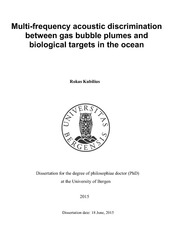| dc.description.abstract | Seabed-originating gas bubble seeps have been observed worldwide from a variety of sources (e.g. Hovland and Judd, 1988) and are most frequently composed of methane and carbon dioxide. Some seabed gas leaks, such as “melting” methane hydrates, may intensify in the coming decades and are a subject of concern in the context of warming seas (Kvenvolden et al., 1993; Archer, 2007). The subsea gas extraction industry and proposed carbon dioxide storage in geological structures under the seabed are examples of potential manmade sources of gas bubble leaks (IPCC, 2005; DNV, 2010), and require swift and precise leak detection and identification. Active acoustic methods are well suited for rapid and cost effective monitoring of large water volumes. Scientific fisheries echo sounders provide calibrated, quantitative measures and are widely used in fish stock monitoring (Simmonds and MacLennan, 2005). As such, these were chosen within the umbrella R&D projects (AKUGAS and AALDOG), the needs of which shaped the scope and objectives of this doctoral study. Bottom-mounted echo sounders, observing laterally along the seabed are considered suitable for gas leak detection. Gas bubble plumes are easy to detect with echo sounders, but separating them from fish and plankton is not always straight forward, as some required information is lacking both for gas bubble plumes and biological targets. This lack is addressed here via selected case studies. In Paper I, the acoustic backscatter properties and natural body tilt orientation were investigated for a common schooling fish that lacks a swim bladder, lesser sandeel (Ammodytes marinus). Its natural orientation distribution was measured using optical measurement methods and is a crucial parameter affecting the acoustic backscattering from animals that are large enough to be directive targets at commonly used echo sounder frequencies. A more advanced stereo photogrammetric method was adapted and improved to fit the needs of this doctoral study in Paper II. These were implemented to characterize the natural tilt orientation distribution of euphausiids (Euphausia superba and Meganyctiphanes norvegica) in several in situ and ex situ experiments (Paper II). Krill natural tilt orientation was measured to have a rather large variability (SD of up to 30-37°). This suggests, but does not prove, that dorsal and lateral aspect krill acoustic backscatter should not be drastically different due to the variable swimming behaviour and body postures adopted by these animals. Such knowledge will be useful for krill multi-frequency identification and target strength averaging either from models or from empirical data. The stereo photogrammetric measurement method (Paper II) was later applied to support fine scale acoustic backscatter measurements on gas bubble plumes (Paper IV) and saithe (Pollachius virens) (Paper III). In Paper III, the lateral aspect acoustic backscatter of saithe was characterised at 70, 120, 200 and 333 kHz. Saithe is a good representative of large, acoustically directive schooling fish that also possesses a gas-filled swim bladder. These can create strong and similar acoustic targets to plumes of free gas bubbles rising from the seabed. Saithe lateral aspect acoustic frequency response (r(f)) was measured based on both schools, single acoustic targets and single target tracks. It was found to have an opposite trend across the acoustic frequency band compared to dorsal aspect saithe r(f) as reported in the literature. The reasons for such discrepancy are discussed along with the implications for acoustic target identification. Similarly, lateral aspect acoustic backscatter properties were characterised for induced methane, carbon dioxide and air bubble plumes at 70, 120, 200 and 333 kHz (Paper IV). A distinct gas plume frequency response was measured for gas bubbles of non-resonant size and is significantly different from the lateral aspect r(f) of saithe. In synthesis, the similarity in acoustic backscattering between a gas bubble and biological targets possessing gas inclusions is discussed, both from a literature review and the investigations included here (Papers I-IV). The prospects of acoustic-based gas bubble plume detection and identification are discussed in the context of obscuring and confounding biological targets. Acoustic frequency response, routinely used to identify some fish and plankton for species or taxa (e.g. Korneliussen and Ona, 2002; 2003; Anon., 2005), is discussed for laterally observed seabed gas bubble plumes. Lateral aspect gas bubble plumes and swim bladder bearing fish frequency response was not available and hence was measured in Papers III and IV. Based on the available research and that defended here (Papers I-IV), it is suggested that behavioural and acoustic backscattering differences can be used to separate gas bubble plumes from the most common biological targets, plankton and fish. Gas-filled swim bladder bearing fish are the most similar biological acoustic targets to the gas bubble plumes. Schooling and swim bladder bearing fish that are quite directive acoustic targets can be separated using the acoustic frequency response information (indications in Paper III). Smaller, but abundant swim bladder bearing fish, such as members from Myctophidae and Sternoptychidae, can be difficult to separate acoustically from a single gas bubble. However, the behaviour of such fish assemblages is substantially different from the gas bubble plumes. Using both backscattering frequency response and behaviour traits (at one time instance and over time) are likely to give the best chances for acoustic-based detection and identification of seabed gas bubble plumes. | en_US |
